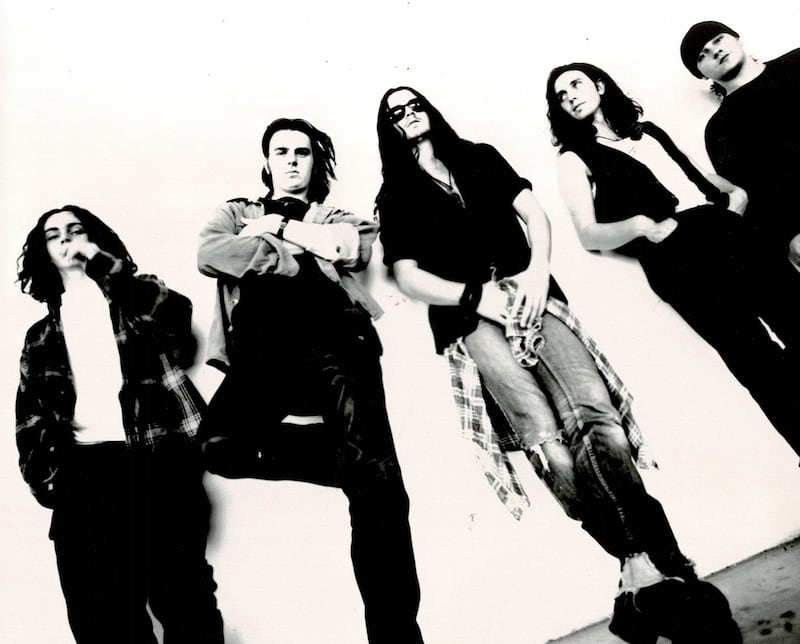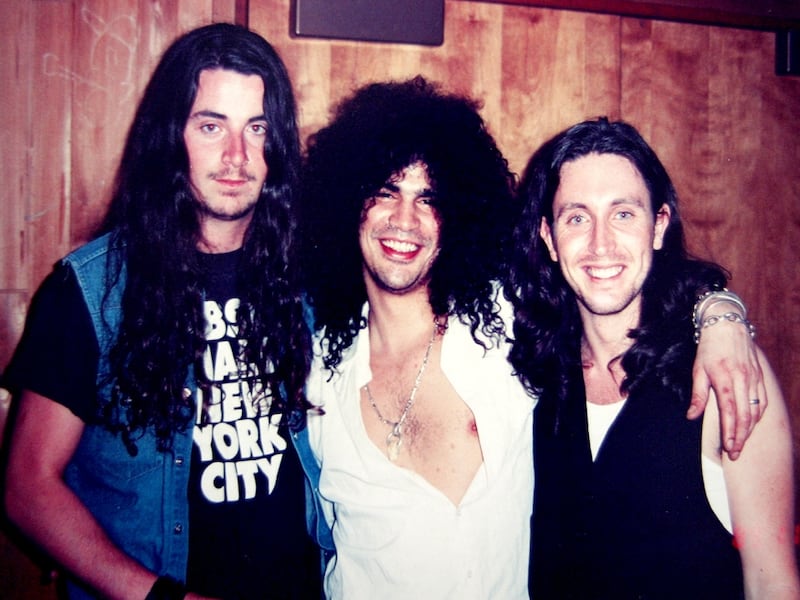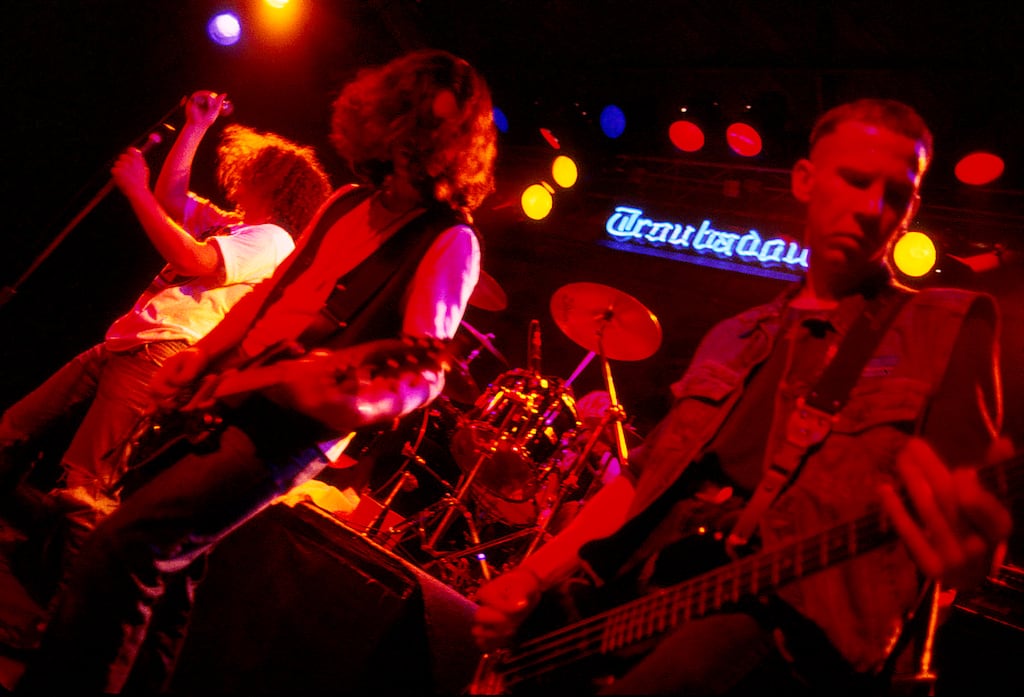Tell us about founding My Little Funhouse
My younger brother Tony was in school with Alan, Gary and Derek. They formed My Little Funhouse — Alan as singer, Gary on bass and Derek on drums — when they were 15. I was 18 and playing in other bands around Kilkenny. They asked me to join, and we started rehearsing in front rooms, sheds, wherever we could get together to write tunes. It was electric — like it was meant to happen, if you believe in all of that.
My friend Michael Lanigan was into music, so we asked him to manage us. It all happened so fast, it was a super-exciting time to be in the music business, and we all got to see the world together.
Listen to Superstar by My Little Funhouse
We played a few gigs at the Pumphouse, Cleere’s and Henderson’s in Kilkenny, then entered the Carling Hot Press competition at Sir Henry’s in Cork and won it. It was our fourth gig. The prize was a publishing deal with Island Music in London. Richard Brown, a young A&R guy, at Island, was assigned to us, and he started pushing us around all the labels. Alan’s voice was spectacular, so because we sounded like Guns N’ Roses every major record label in the world started flying in to try and sign us.
We started recording demos at Sun Studios in Dublin and sending them out. It got so crazy that at our hometown gigs the music industry would fly in and couldn’t get in to see us. They’d be standing outside the venues — like, WTF?
For us, Ireland was never the plan. I think we payed a handful of gigs in Dublin at the Rock Garden, McGonagles, but getting out to see the world was always our goal.

You got a $2 million record deal with Geffen Records. How did you get such a huge contract?
Rumours started to get out around the industry that we were getting signed, I guess. We had our sights set on Geffen Records in Los Angeles because they had most of our favourite bands, and they were the hottest record label in the world. David Geffen was a genius, and I knew if he liked us it would be the right home for us.
Tom Zutaut from Geffen was the biggest A&R guy in the world after discovering Mötley Crüe, Tesla, Guns N’ Roses. He came to see us play in Kilkenny and loved it, so things were heating up.
Listen to Hedgekicker by My Little Funhouse
Louis Walsh, of all people, was our booking agent in Ireland. After one of our Dublin shows a strip group called the LA Centerfolds came to perform at the Olympia Theatre. There was religious uproar about it, so we had to go and check it out for ourselves. We asked Louis to get us tickets, and he sat us up at the top and back of the theatre — so we could see nothing. Teenage boys. The best gig ever and the worst seats ever.
Zutaut was with us and we said to him, “If you get all of those back to the presidential suite at the Conrad, we’ll sign with Geffen Records.” Two hours later they all came marching in. Some photographer — from the Sunday World, I think — got in too. Made for interesting photos and conversations with girlfriends the next day. So that’s how we got signed. Warner offered us a bigger deal, but Geffen was the coolest home for our music.
We flew to LA a week later to meet the folks at Geffen. We had a dinner planned at the Rainbow on Sunset, across from the Geffen offices. David Geffen arrived for dinner, to the amazement of his staff, because he was a bit of a recluse at that stage. He sat with us for pizza and invited us to his home in Malibu the next evening. I asked him: “Did you ever invite Guns N’ Roses out here?” His reply: “Would you invite Guns N’ Roses to your home, Brendan?” Fair point.
In late 1991 we signed the biggest deal in the world for a new band up to that point. Crazy, right? Kilkenny to this in the space of 12 months. Suede were in LA getting wined and dined by Geffen that week too.
Then the managers started to fly in. Tony Dimitriades, who managed Tom Petty, came to Kilkenny. He was with me when we called Tom, who said he was driving over Mulholland Drive listening to our demos and they rocked. Tom f***ing Petty just told me that our tunes rocked. A year earlier we were covering Free Fallin’ because we didn’t have enough songs for a full gig.
Listen to Please God by My Little Funhouse
Cliff Burnstein and Peter Mensch, from Q Prime, New York, arrived in their stretch limo to Kilkenny. The biggest managers in the world — Metallica, Smashing Pumpkins, Def Leppard. They brought contracts with them and put them down in front of us to sign. I don’t know if it was a New York pushy attitude thing, but it scared us, and we said no. I don’t think they were used to people saying no. It was the biggest mistake of our career. I rang John Kennedy, our lawyer in London, to get his advice, and he told me to go with my gut — but my gut was wrong about that one.
Geffen put us in touch with Guns N’ Roses’ managers, Big FD — Doug Goldstein and John Reese. We flew back to LA to meet them. The night we landed they brought us out to the desert where GN’R were shooting their video for November Rain. We were all in the church when Axl was marrying Stephanie Seymour. A bunch of Irish boys in a desert with the world’s most beautiful supermodel and the biggest rock band in the world. You really couldn’t write it.
Management in place, we flew back home. We hired a crew and started rehearsals at the Factory in Dublin. U2 were there rehearsing. We thought we made it, rehearsing next door to U2.
We moved to Camden in London for a few months and recorded our debut record, Standunder, with Bill Price — who produced the Sex Pistols and the Clash — at Air Studios in 10 days. We recorded it live. We were the last band to record at Air on Oxford Street. George Martin used to drop in to see how we were getting on. I mean the George Martin. It was kind of all too much too soon.
We started to tour. One of our first gigs was to open the Hard Rock Cafe in Tokyo. We played there for a month. It was wild. Fans used to hide in bushes outside the apartments, run after the tour bus, bring gifts to every show. Looking back, we probably took too much for granted. For the fans, we were on the same label as Guns N’ Roses, Nirvana, Aerosmith, Beck, Neil Young, Joni Mitchell, Counting Crows, Peter Gabriel, Hole, The Nymphs, Sonic Youth, Black Crows, Weezer, White Zombie, Teenage Fanclub, so it was a big deal — but we didn’t realise it.
I woke up in the midwest one morning after playing support to Candlebox, and we were in the rock charts between Aerosmith and GN’R. I thought, this is it, we’ve cracked it. But Smells Like Teen Spirit was blowing up on Geffen and there was a social shift happening, from rock to grunge. Everything changed. The label changed. They followed the money, the CD sales. Kids were wearing flannels, ripped jeans and Docs. Seattle bands started breaking, like Pearl Jam, Stone Temple Pilots, Mother Love Bone, Temple of the Dog. It felt like the day I saw Kurt in that basketball court on MTV, rock died. My dream died.
What happened to all the money you got — if you got it — in that $2 million deal?
Ha! I wish. We got per diems — a daily allowance — while we toured the world. The rest went on recording, touring, management. We didn’t see it, and it wasn’t managed the way I would have liked, but we were too young to realise. It always feels as if there are a lot of sharks in the music game.

What was the scene like in Los Angeles in the early 1990s?
It was glorious and crazy all at the same time. We were there for the Rodney King riots. We got caught in the middle of the magnitude 6.7 Northridge earthquake. We were living on Barham Boulevard in the San Fernando Valley when it hit. Our apartments were turned upside down; the gas mains meant the roads were on fire; and I don’t know if you remember, but the freeways fell down and people were driving off. I thought we were getting bombed. The aftershocks were the worst while we were in the studio because you never know when it’s going to hit again. Then we had the mudslides. The Malibu fires. I mean, a very interesting place to live but absolutely nerve-racking. Great for creativity because it has to come from drama.
In the middle of all that, the music that was coming out was mind-blowing. I went to see Rage Against the Machine at the Club with No Name — 100 people jammed into one of their first gigs. No gig will ever come close to that energy.
Korn played their first gig supporting us in LA and they blew me away. The records that were coming out every week from Metallica, Red Hot Chilis, Soundgarden, Nirvana, GN’R, all at the peak of their creativity. There won’t ever be a time like that again.
We rehearsed at Mates in the Valley. Alice in Chains were next door. I remember listening to them and thinking, okay, so that’s how good we have to be to compete.
Listen to Maybe by My Little Funhouse
Back at the ranch, Geffen didn’t know what to do with us. We weren’t 80s rock and we weren’t grunge, and we were kids. We toured with Izzy when he left GN’R and set up the Ju Ju Hounds. That was fun, but it didn’t break us. The Cranberries were touring at the same time with Duran Duran and I started to hear Linger all over US college radio. They caught a college wave and we didn’t — and they sold 30 million records on the back of it.
Geffen put us out with Vince Neil from Mötley Crüe, Duff, Thunder. Wrong tours, wrong audience. We did get to play with The Ramones in NYC. That was super-cool.
We recorded three videos for Standunder, our first album: I Want Some of That in London, Wishing Well in Germany and Raintown in the desert on Route 66. Jack Nance starred in that one, from Twin Peaks. Amazing actor.
What do you remember about the Slane gig you played in 1992 supporting Guns N’ Roses?
The limos, low-riders and police escort from our Dublin hotel to Slane were pretty cool. The fans thinking Alan, our singer, was Slash because they had the same hair. I think that was our ninth gig, so getting to play such an iconic venue like that was a bit overwhelming. Especially when 80 per cent of the band were 17 years old. Seeing our friends and fans from Kilkenny come rushing down the hill was unreal.
Lord Henry came by to say hello. He couldn’t have been nicer to us. My girlfriend Karen (now my wife) was my guitar tech, and my friend Derek was the drum tech. We had no crew. We just got them to drive a van with gear up from Kilkenny. Thinking back on it, it was all a bit mad, but it was so fast we didn’t get time to prepare. Soundgarden pulled out of the tour, so we replaced them. The Faith No More crew were lovely to us. Same for the GN’R guys. Some ended up working with us later on.
What happened to the two albums that were never released?
They’re sitting in my office in Kilkenny. The rights reverted back to us a few years ago. I guess we should do something with them someday. Someone stuck our first record up on Spotify recently. It was fun listening back to it.
How did Slash and Matt Sorum get involved in the two unreleased albums?
They performed on the second record. Doug Goldstein and John Reese, our managers, they put it together. The second record was strange. GN’R weren’t recording after Use Your Illusion and were in the process of disbanding, so some bright spark thought, why don’t we turn Funhouse into GN’R? They got Matt Sorum to produce our demos and play drums on the record. Mike Clink, GN’R’s producer, came in to produce it and Slash came in to play on tracks with Tony and myself. It was all weird and it wasn’t us. It seemed corporate and manufactured, like some boy rock band.
I went to New York to mix it with Andy Wallace, who mixed Nevermind, but I knew it wasn’t what we wanted to release. There was a lot of politics going on at Geffen at the time, so bigger powers were at play. It was about to sell to Universal.
We had a firm three-record deal — something unheard of, but that allowed us time to regroup and get back into rehearsals to record three. Todd Sullivan, who discovered Weezer, took over the A&R reins and we brought in Joe Barresi, who produced Tool and Queens of the Stone Age. It felt right — and it rocks. I love that record.
What were the unreleased albums due to be called?
Forward Came and Pulse.
Was there ever a cover for either album?
Yeah, some cool artwork was shot for album two. Album three didn’t even get to a cover which is such a shame because I was proudest of that one.
How did My Little Funhouse break up?
We had come home to Kilkenny in 2006 after the third record for a short break. I got a call from our manager saying, “I don’t think Geffen are going to release the record.” Guess we were too much in debt. Thank god for the recoupable-not-refundable clause in the contract. We had a meeting and called it a day. Wasn’t meant to be — but we gave it our best shot, and I wouldn’t change a minute of it. If Nirvana didn’t come along and change music it might just have happened. Back when rock really mattered.
Listen to Rollin in it by My Little Funhouse
What did you do next?
I got married and had a family. That was my biggest achievement. I guess I’m still creative but not with music. I set up some bars and clubs when I came home. I had artists like Damien Rice play their first shows there but life changed in 2004 when I was introduced to a small company in Palo Alto. I flew up to meet them and thought, this is cool: it’s like MySpace. It was Facebook. I came home to Ireland and did Facebook Garages to teach people about the social network. Facebook followed and set up their European headquarters here in Ireland.
I went on to build social networks across ed tech, med tech, music, talent discovery... I’ve been doing that for the past 20 years with millions of people across our networks, and now I get to help people by building bespoke tech to assist refugees, dyslexia, cancer, autism and mental health.
Technology is very much like music. There’s an art to it, where you create projects that live in peoples’ lives daily and help them get through their day. I love what I do, but music will always be my passion. The older I get the more I appreciate that I got to do something that very few people get to do for a living.











